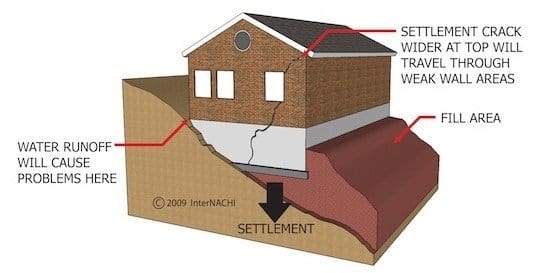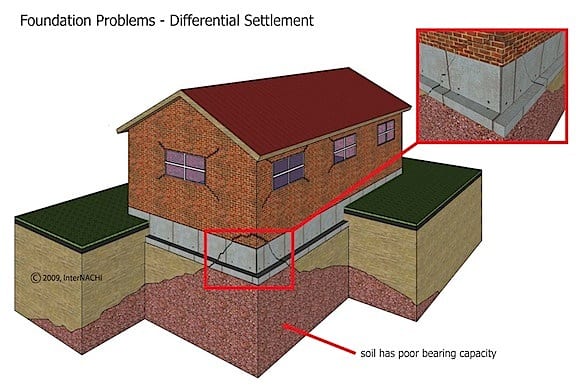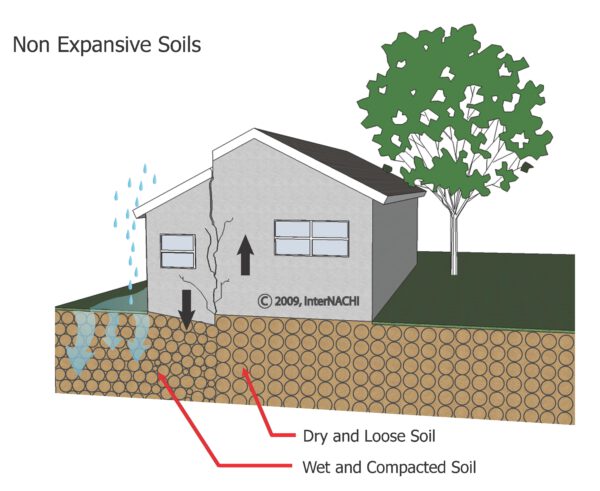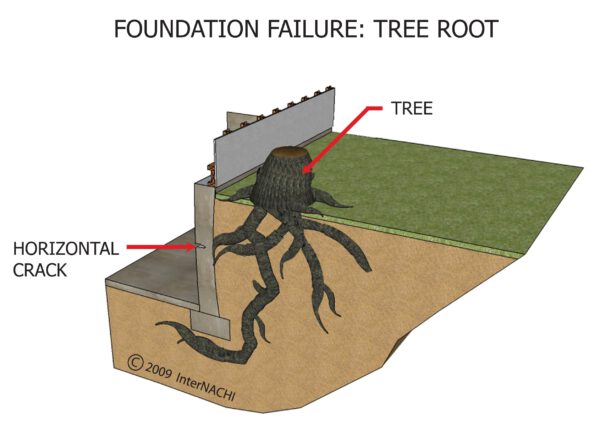Foundation Settlement
What is Foundation Settlement?
Foundation settlement happens when soil shifts beneath a home and it is a serious deal for a homeowner, and often requires that swift action be taken to prevent structural damage from occurring to the home. The causes behind settlement of the foundation are actually rarely due to the actual design or the under design of the home itself. The most common causes for the damage that leads to foundation settlement have to do with changes that occur to the soils around the foundation and the soils that are responsible for surrounding and supporting the entire structure. The following is a look at some of the potential causes for foundation settlement and what they can mean for the future of the foundation and the structure itself.
Weak Bearing Soil Issues
There are certain types of soil that are simply not capable when it comes to supporting the weight of the foundation or bearing the pressure that the foundation of the building exerts. Resulting from this fact, the foundation’s footings can press down or sink into softer soils. In cases such as these, the footings are going to need to be designed in such a way that they are going to spread the load across the weaker soils. The purpose for this is so any potential settlement of the foundation can be reduced.
However, you still need to be aware of the fact that in most problems involving the settlement of the foundation where the bearing soil is weak, the reason is because the residential construction used standard footings rather than better load bearing footings. The reason for this is because the footings are typically going to be designed based on general guidelines rather than on soil information that is specific to the site.

Poor Compaction Issues
Both when developing commercial subdivisions and residential subdivisions, there is a common practice that people will place fill soils. Generally speaking, buildable lots are created by cutting down hilltops or by filling in valleys in order to create spaces that are flat and compacted. Fill soils that are placed properly and compacted properly should be more than capable of creating an adequate amount of support for the foundation of these businesses.
However, it is important to note that when these fill soils are compacted but not in an adequate manner, then they may be capable of compressing under the load of the foundation. The result is that the structure and the foundation can settle, causing structural integrity problems in the future.

Changes in the Moisture Content
When a foundation soil experiences an extreme change in the moisture content, then this can result in damage to the foundation in the form of settlement. An excess amount of moisture is capable of saturating the soil of the foundation, and this can easily lead to a softening or a weakening of silt or clay soils. When the soil is no longer capable of supporting the load, the result is often settlement of the foundation. An increased amount of moisture within the soil beneath the foundation often comes as a consequence when there is poor drainage on the surface around the structure, when there is a leak in the water line, when there is a leak in the plumbing or when there is a raised groundwater table.
Soils that have a lot of clay content in them can also generally have a tendency to shrink when it comes to the loss of moisture. As soils with high clay contents begin to dry out, they can contract or shrink. This is going to result in the general and gradual decrease of the soil’s volume. As a result, settlement damage is often going to be observed when it comes to structures that are supported on soil that has become dried out. Drying out of the foundation soil can often be caused by conditions that are extensively drought-like as well as other causes. For example, maturing vegetation and trees can cause a drying out of the foundational soil. Another cause for drying of the foundation soil is a leaking of an HVAC or heating, ventilation and air conditioning system in the subfloor.

Maturing of Trees or Vegetation
As mentioned above, this is another problem that can lead to settlement of the foundation, and so it must be watched for with time. Maturing of the trees, bushes and any other types of vegetation that are in close proximity to the building of the home is a common reason for foundation settlement to occur. When trees and other types of vegetation mature, they are going to grow in size and as such, the demands they place on the soil for water and nutrients are also going to grow. The root system for these types of vegetation is also going to grow and expand on a continuous basis with time, and as such, the roots are going to be trying to draw moisture out of the soil around and beneath the building’s foundation.
Soils that are rich in clay, as a result of this action, are going to shrink with time as they lose their moisture content. This is going to result in a settlement of the overlying structure including the foundation and the building built over the top of the foundation. Many building owners and home owners have said that they never had any problems with the settlement of the foundation until many, many years following the building of the structure.
Unfortunately, it can take as many as several decades before this type of problem becomes apparent, and so it can make things difficult for the home owner who suddenly has to make repairs to the foundation below the home. The reason for this is because it takes many decades for new vegetation and trees to really grow, and that is why these types of foundation issues really do not crop up until later on in the life of the building.
Foundations that are closer to the surface of the ground are generally going to be affected more often by soil dehydration issues. The reason for this is because of tree roots. Basement level foundations and foundations that are deeper are generally not going to experience as many problems with this type of soil settling issue. As a general sort of rule, the diameter of the root system for the tree is going to be at least as big as the canopy of the tree. Considering this may help you determine whether or not you are going to have issues with mature vegetation in the future.

Soil Consolidation
The concept of soil consolidation is something that occurs when a structure’s weight compresses down on a weaker, lower soil, or when newly placed soil for the purpose of filling does the same thing. A lower clay-based soil that is naturally weaker is not going to be able to withstand the pressure from the structure or the heavier fill soil, and so soil consolidation is going to occur as a result. The applied load is generally going to force some water content out of the weaker clay soil. What this is going to do is to allow for individual soil particles to space out in a denser manner. The consolidation is going to result in a downward movement of these overlying structures, or in a settlement of the foundation as a result.
When settlement is caused by a consolidation of the foundation soil, it typically occurs over a lengthy period. This type of foundation settlement can generally occur over several weeks, several months or even several years before it is considered to be complete.
Dealing with Foundation Issues
Unfortunately, when foundation settlement begins to occur, you are already in trouble. It is vitally essentially that you start dealing with this problem as soon as possible so that you can nip it in the bud before it becomes even more serious. If your foundation is sinking or settling, then there is a good chance that it is going to continue to do so until help is provided. The best thing that you can do is to determine the exact cause of the foundation settling so that you can prevent it from becoming worse.
If you are ever in doubt about what is causing your foundation to settle, it would be very wise for you to bring in some professional help so that you can get feedback and advice. Because it is so essential that you stop allowing the foundation to sink or settle, getting quick and effective professional help is going to be a really important consideration for you to make.
Dealing with a settling or sinking foundation quickly and effectively is the best way to save and preserve the structural integrity of your structure, allowing it to stay in good condition for many years to come. If you do not address the problem, the continued settling may jeopardize the structural integrity of your building, causing it further harm and potential damage in the process.